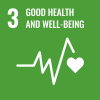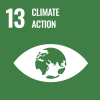Massagada, 22 May 2023 – Nima was asleep when disaster knocked on her door seven months ago.
“We woke up with water under our feet and had to leave everything so quickly,” she remembers of that fateful night when the waters of Lake Chad flooded her home in Tchoukoukapi, a small village on the shores of one of Africa’s largest lakes.
In the middle of the night, Nima woke up her children, gathered a few belongings and left her home in search of safety. That night, entire fields of crops were destroyed as the whole village had been flooded.
After a long and perilous journey on foot across smaller villages, Nima and her family arrived in Massagada, a spontaneous site founded by people displaced by the floods that would become their new home.
Having lost her home, all she wanted was a roof over her head.

Nima and her husband Modou outside their shelter built by IOM as part of emergency relief activities in the Lake province. Photo: IOM/Francois-Xavier Ada 2023
In 2022, Chad experienced one of the worst floods in its recent history. An overflow of the Logone and Chari rivers, which cross the capital N’Djamena and serve Lake Chad, destroyed nearly 500,000 hectares of agricultural fields across the country, affecting more than 1 million people, according to the United Nations.
The record floods caused the water levels of Lake Chad to increase, inundating many of the islands on the Lake and destroying several shoreside villages, forcing thousands of people to flee in search of safety.
That same night, Alhadji and his wife Hadje were also asleep when the rising lake waters tore them from their sleep. Although they were not unfamiliar with rising water levels, they were unprepared for the scale of the floods. “We did not think it would swallow our houses,” Alhadji says, looking through the few items he was able to rescue.
“We put our youngest children on donkeys with some of our most prized possessions and the rest of us walked, leaving everything behind,” he adds.
For families like Nima’s and Alhadji’s who have been displaced and lost everything, finding shelter is critical.
“Losing one’s home is a devastating experience; this is why sheltering victims of disaster and internally displaced persons (IDPs) is a core humanitarian intervention,” explains Tamia Ngodji, Shelter Expert with the International Organization for Migration (IOM) in Chad.


Alhadji and his wife Hadje pose in front of their shelter built by IOM. Photo: IOM/Francois-Xavier Ada 2023
In Massagada, IOM partnered with the EU Civil Protection and Humanitarian Aid to build 400 shelters to provide emergency relief to the victims of the flood.
“Shelters provide personal safety, security, and protection, and help restore communities’ dignity while empowering them to become more resilient to future shocks,” he adds.
The shelters are made of straw walls built on a wooden structure which makes them resistant to extreme weather while allowing air circulation. In line with standards, the shelters are spacious enough for a family and include an internal separation for more privacy and comfort.
For Nima, the shelter was life-changing. When they arrived in Massagada, she and her family lived in a makeshift tent made of pieces of dry wood covered with cloth and depended on the compassion of their hosts for their survival. “The mats and blankets that you see here were offered to us by the locals,” she says, pointing to a pile of covers.
But today, she lives in a new home and is hopeful about her future. “I feel good here; before, we did not have water or access to health care but today, we live near a well and we feel safe in our shelter.”
With support from the EU Civil Protection and Humanitarian Aid (ECHO), IOM has built 650 emergency shelters providing safety and security to more than 3,470 people affected by last year’s floods in Chad.
This story was written by François-Xavier Ada.



